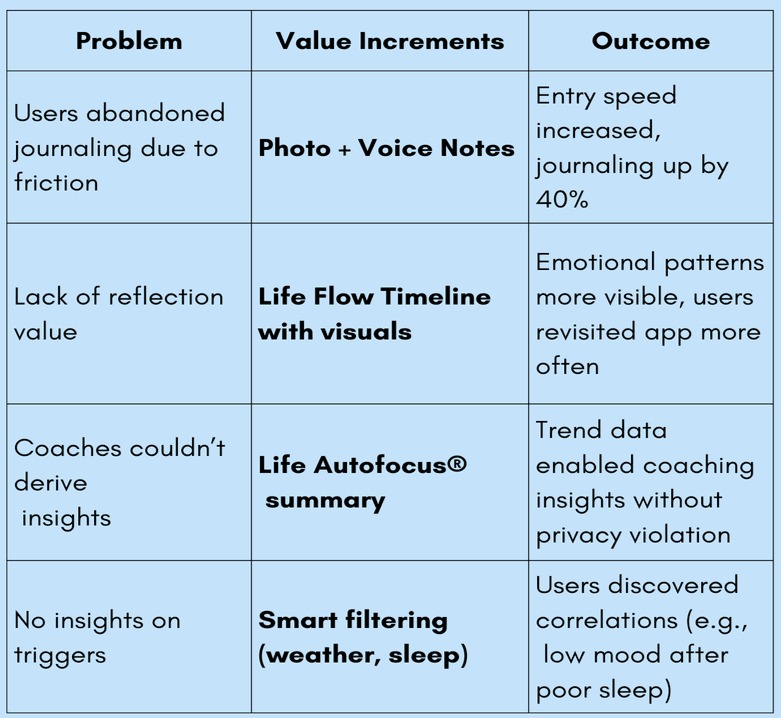A Wellbeing App’s Journey to Visual Excellence
Background
The wellbeing app’s mission: to help individuals increase self-awareness and improve mental wellbeing through the power of daily reflection and contextual insights. At its heart, it aimed to become a personal guide, an emotionally intelligent app that helped users to express their emotions, adapts to life’s rhythms, helping users track, understand, and shape their inner world.
Goal
Engagement metrics confirmed its usage dropped off quickly after a few weeks of onboarding, and retention plateaued well below expectations.
The Challenge
Initially, the application faced criticism for its user interface and user experience. The feedback highlighted issues such as a lack of intuitiveness, longer navigation paths, and inconsistent touchpoints for different stakeholders.

Compounding the issue was the transition of the development team, which resulted in substantial information loss and gaps in communication between stakeholders and developers. As a result, direct feedback from users was often overlooked, and some existing feedback lacked the necessary context to be actionable. The goal was to review the end-to-end design and customer workflow and help the client get the app updates quickly to the App Store.
Despite a strong intent, our early reviews painted a troubling picture:
- Journaling felt like a blank slate chore
- Contextual data from wearables (heart rate, sleep, weather) was not meaningfully integrated
- Users couldn’t see patterns or get insights
- Coaches and professionals couldn’t extract value from raw user entries
- Journaling felt like a blank slate chore
- Contextual data from wearables (heart rate, sleep, weather) was not meaningfully integrated
- Users couldn’t see patterns or get insights
- Coaches and professionals couldn’t extract value from raw user entries.
Step 1 – Defining the User Jobs
The team went beyond “feature asks” and understood what user segments were trying to accomplish and respected pain points.
User X
- Job: “Capture daily emotional reflections quickly and revisit them to spot patterns over time.”
- Pain Points:
o Overwhelmed by text input
o Struggled to remember key moments
o Wanted clarity on recurring mood triggers.
User Y (Corporate professional)
- Job: “Do a quick mental check-in during breaks or after meetings to decompress and recalibrate.”
- Pain Points:
o No time for journaling
o Needed voice-to-text or gesture-based input
o Wanted fast emotional summaries.
User Z (Wellness professional)
- Job: “Gain insight into clients’ emotional states between sessions without prying or micromanaging.”
- Pain Points:
o Couldn’t interpret vague journal entries
o Needed consent-based data summaries
o Desired trend reports, not raw notes.
Step 2 – User Research and Contextual Inquiry
The team knew usage was dropping, but metrics alone couldn’t explain why. So, we turned to users’ heads and habits. We used the data-driven approach to identify new users who dropped off after a few days, and a good mix of long-term users with inconsistent usage. We identified the reasons why they would choose to use the app.
Key Insights:
- Journaling was often triggered by emotionally intense moments (positive or
negative). - Users wanted lightweight input and visual reflection, not heavy writing.
- The app didn’t support reflection as a loop it only offered entry, not feedback.
Step 3 – Mapping the Emotional Journey
The team created user journey maps focusing on emotional states across five journaling stages:
Trigger – User feels compelled to record something (mood shift, insight, event)
Action – Launch app, choose a feature (often abandoned here)
Entry – Attempt to record thoughts (text/voice/photo)
Review – Reflect on past entries (mostly underused)
Meaning – Seek insights or patterns (rarely fulfilled)
The journey revealed emotional friction points, especially between ‘Action’ and ‘Meaning’. The coaching tips feature was important both to read their past patterns and also provide coaching tips based on their current mood.
Step 4 – Prioritization and Execution
To address key priorities without overwhelming the roadmap, we implemented a focused incremental delivery approach. By deploying the smallest valuable features first, we systematically built complete end-to-end core functionality before tackling the next highest-value items, directly addressing the root causes of user drop-off. Our rapid production feedback loops incorporated in-app rating widgets to capture real-time user sentiment. Throughout this process, we maintained sensitivity to the human experience by developing comprehensive emotional journey maps that guided our planning decisions.

